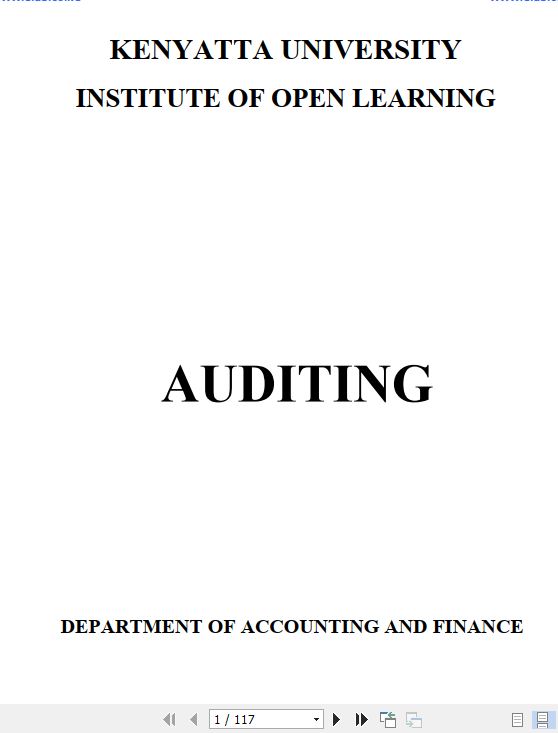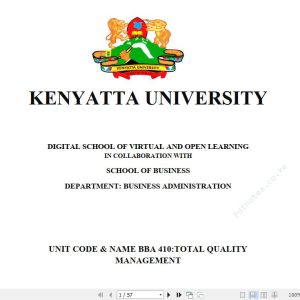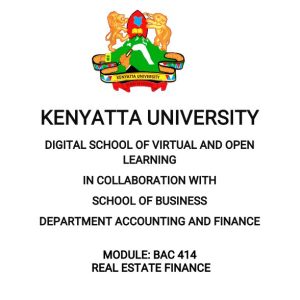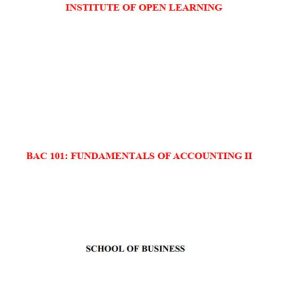Description
TABLE OF CONTENTS
1.0 LESSON ONE
1.1 Introduction
1.2 Definitions
1.3 Need for audit
1.4 Parties to financial statements
1.5 Objectives of an audit (Aims of an Audit)
1.5.1 Primary objectives of an audit
1.5.2 Secondary Objects of an audit:
1.6 Changes in auditing objectives
1.8 Differences between Auditing and Investigation
1.9 Qualities of an auditor (Traits/Features/Characteristics of an Auditor)
1.10 Professional Etiquette or Ethics of an Auditor
1.11 Accounting standards and the auditor
1.12 Documents that auditors and auditing students should be aware of:
1.13 Relevance of accounting standards to auditing
2.0 LESSON 2: TYPES OF AUDIT
2.1 Introduction
2.2 Classification of Audits
2.2.1 According to the Nature of Work Done
2.2.2. Classified according to the method of approach to the audit work
2.3 Summary
3.0 LESSON 3: APPOINTMENT OF THE AUDITOR
3.1 Introduction
3.2 General Approach
3.3 Appointment of the Auditor (Specific)
3.4 Who can be an Auditor (Qualifications)
3.5 Who cannot be an Auditor (Companies Act Section 161(2)
3.6 Remuneration of the Auditor
3.7 Removal of an auditor
3.8 Rights of the Auditor (Given by the Companies Act Cap 486)
3.9 Duties of the Auditor (Statutory)
3.10 Auditor’s independence (Importance)
3.11 Powers of the Auditor.
3.12 Summary
4.0 LESSON 4:ACCOUNTING SYSTEM AND RELATED INTERNAL CONTROLS
4.1 Introduction
4.2 Definitions
4.3 Types of internal controls
4.4 Advantages/objectives of having internal controls in a business
4.5 Limitation of internal control
4.6 Internal control in specific areas of a business
4.7.1 The control environment
4.8 Accounting system
4.8.1 The auditor’s interest in the client’s accounting system
4.8.2 The management’s interest in the accounting system
4.8.3 The need for controls over the system.
4.8.4 Auditor’s procedures with regard to accounting system and related internal controls.
4.9 Ascertaining and recording the system of internal controls
4.9.1 Methods for recording the system
4.9.2 Methods of Ascertainment
4.10 Evaluating the system of internal controls
4.11 Compliance tests
4.12 Substantive tests
5.0 LESSON 5: AUDIT EVIDENCE.
5.1 Introduction
5.2 Financial statements and assertions.
5.3 Auditors and evidence
5.4 Limitations of quality and quantity of audit evidence
5.5 Types of audit evidence
5.6 Categories of audit evidence
5.7 Basic techniques for collecting evidence
5.8 Test checking.
5.9 Quality of audit evidence
5.10 Procedures For Collecting Evidence
6.0 LESSON 6: AUDITOR’S REPORT TO THE SHAREHOLDERS AND TO THE MANAGEMENT
6.1 Introduction
6.2 Seventh schedule (s.162): matters to be expressly stated in auditor’s report
6.3 Key words in the schedule
6.4 The auditor ‘s report to share holders
6.4.2 Principles of qualifying reports
6.5 Contents of Auditor’s report to the shareholders






Reviews
There are no reviews yet.